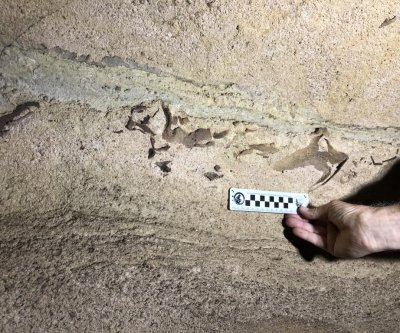
After 16 years, the Spitzer Space Telescope's science mission is over
by Brooks HaysJan. 31 (UPI) -- NASA's Spitzer Space Telescope has spent the past 16 years rendering the universe and its many phenomena in infrared, providing scientists clues to the secrets of stellar formation, supernovae, quasars, exoplanets and more.
But no longer. NASA confirmed the end of Spitzer's scientific mission Thursday. Shortly after engineers shut off the telescope's instruments and put the spacecraft into safe mode, Joseph Hunt, Spitzer's project manager, declared the mission over.
Spitzer was one of NASA's four Great Observatories, along with the Hubble Space Telescope, Chandra X-ray Observatory and the Compton Gamma Ray Observatory.
"Spitzer has taught us about entirely new aspects of the cosmos and taken us many steps further in understanding how the universe works, addressing questions about our origins, and whether or not are we alone," Thomas Zurbuchen, associate administrator of NASA's Science Mission Directorate, said in a news release. "This Great Observatory has also identified some important and new questions and tantalizing objects for further study, mapping a path for future investigations to follow. Its immense impact on science certainly will last well beyond the end of its mission."
Spitzer's sensitivity to faraway infrared emissions was key to penetrating the gas and dust that shrouds many of the universe's most interesting phenomena.
Launched in 2003, the telescope was only expected to conduct science for two and a half years. Like so many NASA spacecraft, the observatory outlasted its shelf life and exceeded expectations.
Over the years, Spitzer enabled a variety of significant scientific discoveries.
In 2017, Spitzer helped scientists discover and characterize seven Earth-sized planets orbiting an ultra-cool dwarf star named TRAPPIST-1.
"This is the most exciting discovery we've had yet with the Spitzer Telescope," Sean Carey, manager of the Spitzer Science Center, said during a press conference announcing the findings.
In 2009, Spitzer helped scientists produce the world's first weather map for an exoplanet. The telescope plotted the temperature variations across the surface of a giant gas planet, HD 189733b.
That same year, Spitzer also spied a previously unknown ring around Saturn, a thick but near-invisible outer ring composed of dust and debris knocked loose from Saturn's moon Phoebe.
In 2015, Spitzer helped scientists watch a dying star become a black hole. More recently, the telescope assisted in the discovery of dozens of massive, ancient galaxies.
Over the course of the telescope's lifetime, Spitzer's data empowered hundreds of scientific studies. And though its instruments are no more, all of its archived data remains publicly available -- certain to inspire many more scientific discoveries.
"I think that Spitzer is an example of the very best that people can achieve," said Michael Werner, project scientist on the Spitzer mission. "I feel very fortunate to have worked on this mission, and to have seen the ingenuity, doggedness and brilliance that people on the team showed. When you tap into those things and empower people to use them, then truly incredible things will happen."
(0) Leave a comment
upi.com/6980665
Latest Headlines

Science News // 11 hours ago
Ancient shark found inside Kentucky's Mammoth Cave
Jan. 30 (UPI) -- Scientists have identified the 330-million-year-old remains of an ancient shark inside Kentucky's Mammoth Cave National Park.

Science News // 16 hours ago
Rocket Lab successfully launches U.S. spy satellite
Jan. 30 (UPI) -- U.S. launch company Rocket Lab launched a U.S. spy satellite from New Zealand on Thursday.

Science News // 19 hours ago
Some trees respond to weight increases by thickening their stems
Jan. 30 (UPI) -- New research suggests most healthy trees have a built in system, called vertical proprioception, that allows them to respond to weight increase with radial growth of the stem.

Science News // 23 hours ago
Bats inspire new technique to find corroding metal in oil, gas pipelines
Jan. 30 (UPI) -- Using the unique ultrasound system deployed by bats as inspiration, engineers have developed a new way to locate corroding metal in oil and gas pipelines.

Science News // 1 day ago
Unusual carnivorous dinosaurs called noasaurids lived in Australia
Jan. 30 (UPI) -- New fossil evidence suggests an unusual group of predatory dinosaurs called noasaurids lived in Australia during the middle to late Cretaceous Period.

Science News // 1 day ago
Scientists share highest resolution image of the sun's surface
Jan. 29 (UPI) -- Scientists have released the first images captured by the National Science Foundation's Daniel K. Inouye Solar Telescope -- the highest-resolution images of the sun's surface yet to be captured.

Science News // 1 day ago
NASA's Voyager 2 spacecraft recovering from glitch
Jan. 29 (UPI) -- The Voyager 2 spacecraft suffered a glitch over the weekend, according to a news release from NASA, but the probe is now recovering and will soon resume scientific activities.

Science News // 1 day ago
Glue of orb-weaver spider in Japan uses moths' defenses against them
Jan. 29 (UPI) -- According to a new study, the glue that coats the silk threads of certain spider species quickly thins out and spreads out across the scales and base of the wing.

Science News // 2 days ago
SpaceX launches fourth batch of Starlink satellites
ORLANDO, Fla., Jan. 29 (UPI) -- SpaceX recovered its first-stage booster by landing it on a barge at sea, and caught one of the rocket nose-cone halves in a net on another ship at sea in the third successful catch for the firm.

Science News // 2 days ago
Flowers get better pollination services in the city
Jan. 29 (UPI) -- Urban flowering plants are better pollinated than rural flowers, according to a new study.